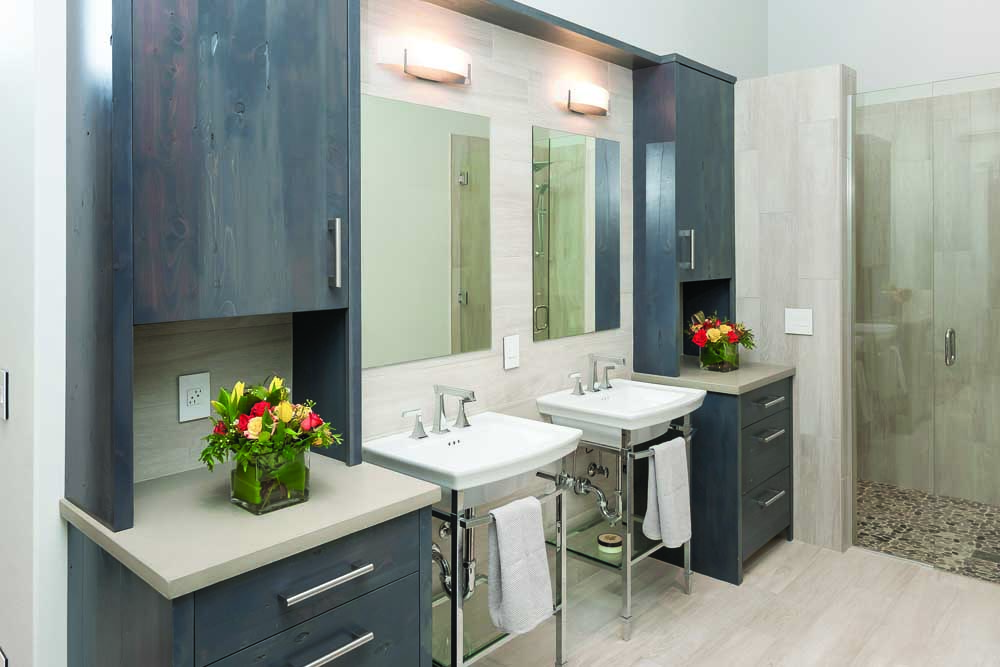New uses for a familiar nuisance
Published 12:00 am Saturday, March 26, 2016

- New uses for a familiar nuisance
The natural-wood exterior of this newly built home seems to perfectly blend with Tetherow’s High Desert appearance. The 4,193-square-foot home, designed by local custom home-builder Neil Kelly, arises from the surrounding brush as if it was always designed to be there.
The exterior is beautiful, but otherwise offers little clue at first glance as to what makes it atypical. A closer look at 61518 Skene Trail, though, reveals something altogether different.
The siding offers two tones: One, cedar planks that rise vertically. The other? A natural-looking siding that uses horizontal planks made from local juniper trees. In a home with an efficient cocktail of sustainable touches, it is this home’s use of juniper that sets the Neil Kelly design apart from many of Central Oregon’s homes.
The home is dotted with juniper outside and inside, including some cabinets (Neil Kelly Cabinets has dabbled with juniper cabinets for years).
“Juniper is a hardy wood,” said Neil Kelly’s Nate Ewen, who designed the Tetherow home, which is listed for $1.995 million. “It’s extremely durable for exterior uses. … Juniper outperforms everything in terms of longevity.”
For many, including area ranchers, Western juniper is considered a rapidly spreading nuisance. Since 1930, the juniper population in Central and Eastern Oregon has exploded from an estimated 1.5 million acres to as much as 9 million acres, according to Sustainable Northwest Wood, a Portland-based nonprofit that specializes in juniper.
The thirsty conifers can suck as much as 40 gallons of water per day out of the ground, which can wreak havoc on the water table and native plants and animals.
Even though using juniper as lumber could help the infestation problem, the extremely dense wood has largely been underutilized as a lumber source. (Oregon passed two bills in 2015, HB 2997 and HB 2998, aimed at spurring the juniper industry.)
The industry is very much local. The wood on the Neil Kelly home was harvested from ranchland between John Day and Baker City, milled in the John Day area, and supplied to Neil Kelly by Sustainable Northwest Wood and Bend’s Parr Lumber.
“It is not well-known yet, but there is a full-scale industry related to juniper,” said Ewen. “It is a local story with a lot of hands involved with it. And now that people have learned about it and have seen it here, it’s just opening people’s minds to consider a different product.”
Notoriously difficult to work with because of its density, juniper does provide some advantages as a building material. According to an ongoing Oregon State University study, juniper lasts “30+ years longer than any other untreated western species.”
More than that, when used properly, it’s knotty, cracked appearance can be striking. It often grabs potential homebuyers’ attention when they tour the home, said Kate Ewen, Realtor for Total Property Resources and the listing agent on the Tetherow home.
“We do get a lot of questions and comments about the juniper,” said Ewen (who is married to Nate). “Some people were surprised at how expensive that product can be, because there is an abundance of it. But it’s not cheap. So people like that they were able to use it and use it how they did.
“It’s very well received,. A lot of buyers are getting into the sustainability features of homes and having the home work for you.”
The four-bedroom, three-bath open design was also built to be energy efficient.
It features ultraviolet-resistant, triple-pane windows, offering views of the Cascade Range and the moonscape-like fairways of the Tetherow golf course. The wall construction has staggered stud walls, which helps keeps the hybrid insulation uniform.
The home is sealed airtight, and the indoor air is freshened with a heat recovery ventilator. The ultra-efficient and ductless “Mini Split” heating and cooling system includes eight separate units placed in different locations throughout the home.
The roof allows rain and melted snow to collect for use in outdoor irrigation. And solar photovoltaic panels help supplement electricity.
All told, the efficient touches will whittle the electricity bill down to about $50 a month, according to Neil Kelly, which aims to increase its local sustainable home business.
“Neil Kelly has been at the forefront of green building since before it was popular,” said Chuck Schermerhorn, Neil Kelly’s general manager of Bend operations. “We have been promoting green, sustainable and natural building since the 1960s.”
Of course there are trade-offs in building a sustainable home, particularly when it comes to cost, Nate Ewen said. And while most of the sustainable technologies used in the home have been used before, Ewen is confident that this home is the right mix.
“There are 100 ways to pursue efficiencies and sustainability, and this is the particular recipe that we came up with that stay in tune with the budget and a whole lot more,” he said. “We tried to design it to make it practical, affordable, comfortable and efficient for the homebuyer.”






